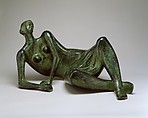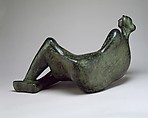Reclining Figure, No. 4
Henry Moore British
After his studies at the School of Art in Leeds and the Royal College of Art in London, in the early 1920s Henry Moore embarked on a very successful career as a sculptor that lasted until his death in 1986. His first works were direct carvings in stone and wood that reflected the ancient Egyptian, African, and pre-Columbian sculptures he saw on his frequent visits to the British Museum. Later, he also worked extensively in bronze, which allowed him to produce multiples of the same image. Although the style and content of his art evolved over sixty years—sometimes exploring highly abstract forms and, at other times, very representational images—his subject matter was almost always tied to the human figure. Reclining and seated figures (mainly women) and family groupings of parents and children were recurring and major themes in both his sculptural and graphic work.
This expressive bronze, with its mottled green patina, is typical of his work from the 1940s and 50s, and reflects his renewed interest in surface texture and solid form following a period of making abstract sculptures that often contained large openings and stringed portions. Capturing the physicality of the human body without succumbing to exacting realism, Moore exaggerates the woman's relaxed pose and the shape and relative sizes of her limbs, head, and torso. The drapery cascading over her thighs recalls a recent trip to Greece, where the artist was inspired by classical sculpture. Here, as in those ancient sculptures, the woman's head and long neck are held regally, her features abbreviated into a generalized mask.
Due to rights restrictions, this image cannot be enlarged, viewed at full screen, or downloaded.
This artwork is meant to be viewed from right to left. Scroll left to view more.




